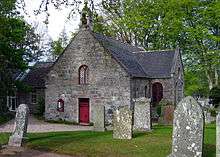Maryculter
Maryculter (![]()

Ancient history
Traces of early peoples from the Stone Age to the Iron Age have been found in the area.[1] Prehistoric habitation in the Maryculter area is known through archaeological sites such as Balbridie situated somewhat west of Maryculter. Roman legions marched from Raedykes to Normandykes, marching slightly west of Maryculter, as they sought higher ground evading the bogs of Red Moss and other low-lying mosses associated with the Burn of Muchalls. That march used the Elsick Mounth, one of the ancient trackways crossing the Grampian Mountains,[2] lying west of Netherley.
Notable residents
- Rev. Prof. George Glennie FRSE DD (1768-1845), minister, born and raised in the village
- George John Robert Gordon (1812-1912), diplomat, born in Maryculter
- Rev. William Selbie (1823-1895), minister of the Free Church in Maryculter from 1853 to 1895[3]
Line notes
- "Scheduled Ancient Monuments". Road Sense. Archived from the original (xls) on September 28, 2007. Retrieved 2007-02-23.
- C. Michael Hogan, Elsick Mounth, Megalithic Portal, ed A. Burnham
- Ewing, William Annals of the Free Church
References
- John A. Henderson (1892) Annals of Lower Deeside: Being a Topographical, Proprietary, Ecclesiastical, and Antiquarian History of Durris, Drumoak, and Culter, D. Wyllie and Son, 271 pages
- C. Michael Hogan, Elsick Mounth, Megalithic Portal, ed A. Burnham
External links
| Wikimedia Commons has media related to Maryculter. |
Bibliography
Nicol, Norman D (1999) Maryculter in the Eighteenth Century: Lairds, Kirk and People in a Lower Deeside Parish

